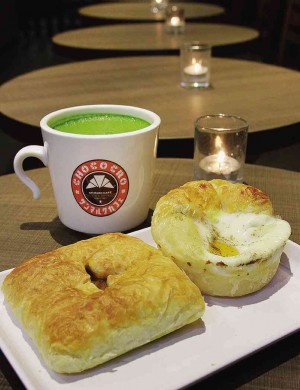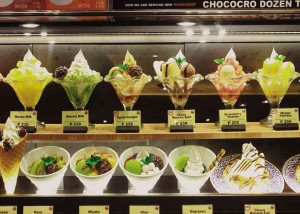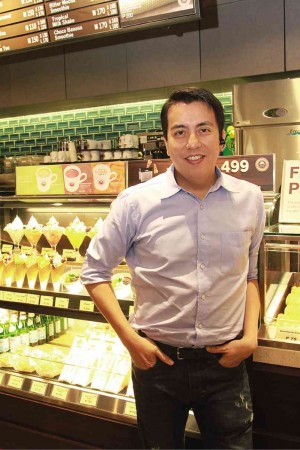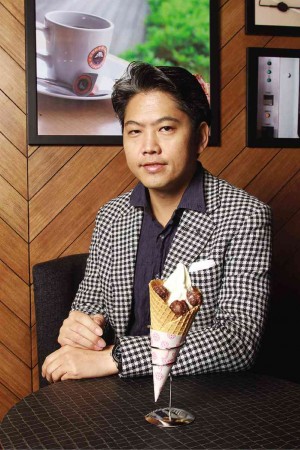
While visiting Osaka, retail magnate Ben Chan discovered Saint Marc Café. Instinctively, the Suyen Corporation chair and CEO knew that the concept would click in the Philippines.
As the trendy Japanese embrace European panache, Saint Marc café-bakery chain is enjoying brisk sales—French pastries reflecting Japanese taste and sensibilities.
Saint Marc Café has transformed the croissant from a chic breakfast fare to a marketing wonder. Chan—who has turned Bench into a global brand—strikes again.

On its first weekend, Saint Marc Café at the Fashion Hall in SM Megamall sold a thousand Chococros a day for P55 a pop. The café’s signature pastry, while still flaky and layered, tastes like a soft roll with a sweet, yeasty flavor. The pastry envelopes a bar of luscious chocolate and is baked until it trickles to the ends.
It goes well with the bitter sweetness of matcha or green tea latté, enriched with creamy milk.
Saint Marc Holdings is a Japanese company of 12 dining concepts and a chain of cafés and restaurants in the United States, China and Southeast Asian countries.
Following Euro-fads, the founding president, Naoyuki Katayama, started a bakery-restaurant with a French café ambience in Tokyo in 1987. It became famous for the free-flowing mini-buns and breads with sweet bean filling.
In 1996, Starbucks debuted in Ginza and took the market by storm. Katayama observed that its success was attributed to the speedy service, more than the products.
He realized that to increase sales, he would have to reduce the fermentation time of the dough to produce fresh pastries every hour. Saint Marc Café evolved into a quick-service dining establishment serving pastries and Japanese desserts.
Katayama’s first experiment was the Chococro, crispy and buttery like the croissant but more chewy. Then came the variants—chocolate and cream; green tea-infused chocolate called matcha daifuku and the strawberry daifuku, a mixture of bits of rice cake, strawberry-tinged chocolate and red bean paste. These croissants with fillings have been Saint Marc’s staples.
Anyone with a sweet tooth will enjoy the nut-flecked almond sugar pie, a Danish pastry that melts into a buttery mouthful.

Savories
Then there are the savories. The egg salsa is made of the same croissant dough, rounded out to serve as a well. The croissant bottom soaks up the Eggs Benedict, tomato and bacon sauce. The egg foldover encases a meaty filling of egg salad and mushroom while another Danish variant has tuna and potatoes.
The curry bread is a square of crisp, delicate layers of puff pastry, loaded with the complex of curry flavors for its filling.
The Fuji Dessert, mimicking the snow-capped Mount Fuji, is a contradiction of warm puff pastries topped with a whirl of cold cream and drizzled with syrups.
All these can be washed down with the hot and cold beverages that are as exotic as the iced yuku (Japanese mandarin orange) tea or the familiar Vietnam hot coffee with condensed milk at the bottom.
Taka Miyake, Saint Marc’s managing director for Southeast Asia, said the company hires coffee masters who select coffee beans from international sources. The beans are roasted in Saint Marc factories in Japan and shipped to its chains.
He observed that Filipinos have to be oriented on Saint Marc’s repertoire of Japanese cold desserts.


of Japanese in our desserts.”
The Wa Desserts (short for wagashi, traditional Japanese confections using red bean paste and mochi or glutinous rice cakes) are served in cone-shaped white cups and carry references to Japanese culture.
Nara, an ode to Japan’s historic city with ancient temples, is an iced dessert of green tea-flavored jelly, red bean paste and a soft cloud of cream.
Gion, named after Kyoto’s famous geisha district, is a dessert of rice cakes that remind one of the white make-up of the courtesans. Green tea ice cream and red bean balls add color.
Miyako, a city in Iwate Prefecture, is represented by cubes of warabimochi, gelatinous starch dusted with toasted soybean flour.
Filipinos could relate to the shaved ice kachang desserts, similar to the halo-halo, except that they are served in bowls and artfully composed to tease the eye.
Most tempting is the choco berry parfait that folds in a light vanilla ice cream with bits of sponge cake, milk pudding and strawberries.
Miyake pointed out that Saint Marc Café is essentially a coffee shop and bakery with the essence of Japanese culture.
But he maintained that its identity is more global than Japanese.
Prices range from P75-P110 for pastries; P150 for hefty sandwiches; P85-P180 for beverages; P150-P230 for desserts.
Bryan Lim, Suyen’s vice president for business development, said the company, as franchise holder, will open 40 branches in eight years.
At SM Fashion Hall, Saint Marc Café is surrounded by popular restaurant concepts. Lim is unfazed: “We complement each other.”









































